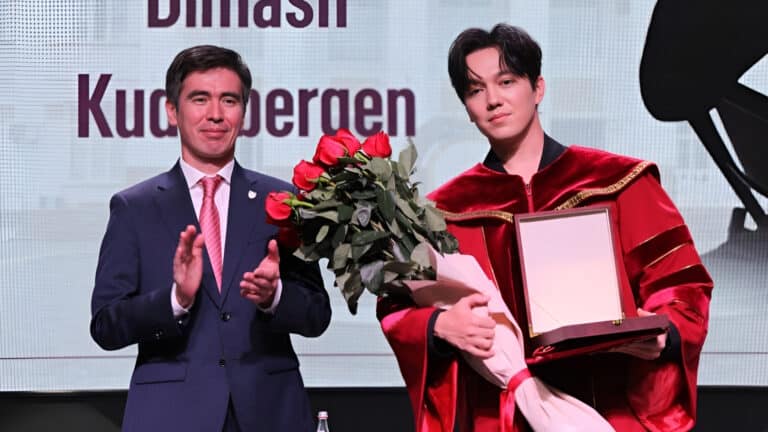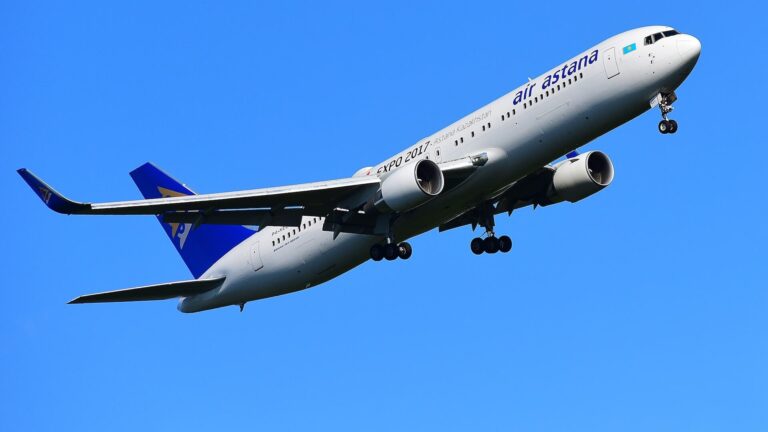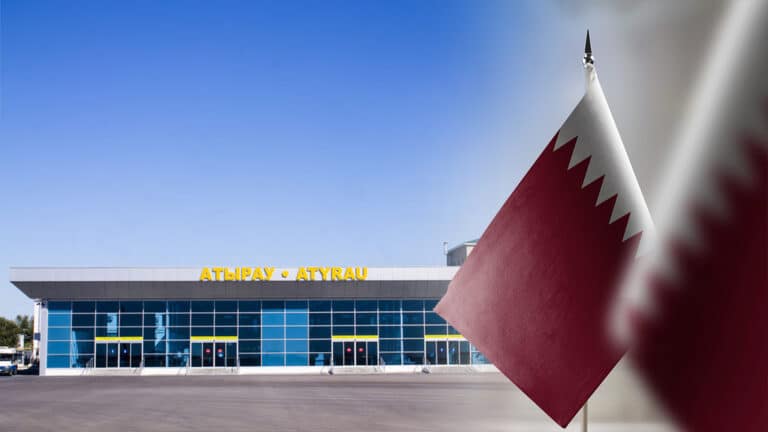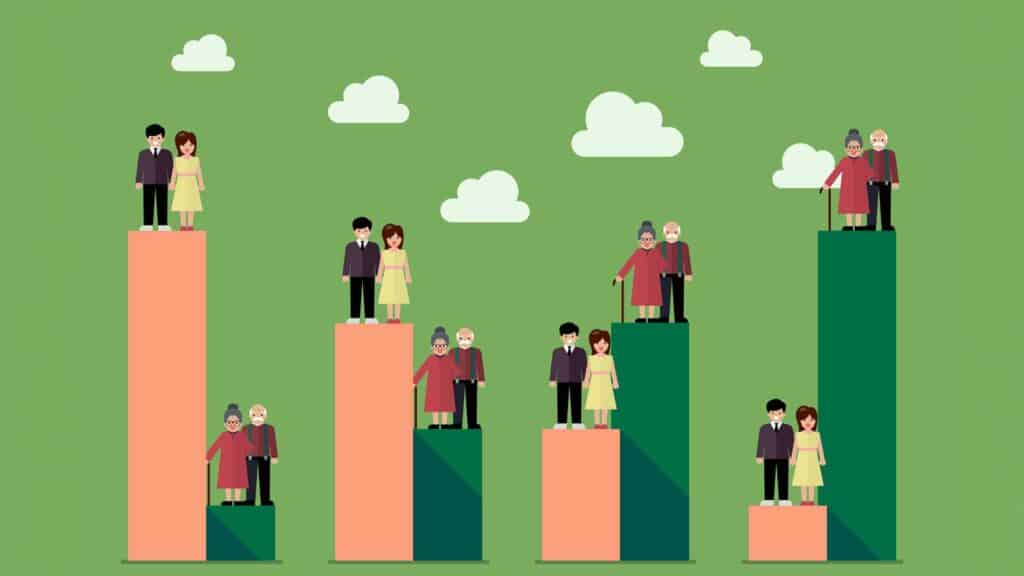
For the sixth month, Freedom Finance Global has been studying consumer confidence, inflation and devaluation expectations of residents of Central Asian countries, including Kazakhstan, Uzbekistan, Kyrgyzstan and Tajikistan. December 2023 was an important month for the study, as it allowed for semi-annual conclusions to be drawn. Also, taking into account the end of the calendar year, respondents were asked about their expectations for 2024 and what changed in 2023.
Last December, it is being noted that there is general decline in consumer confidence in the three countries. The population’s assessments of favorability of large purchases were especially notable, which decreased in all four Central Asian states. Nevertheless, the second half of 2023 can be called positive, since consumer confidence increased during this period, and the year ended in a positive zone for all countries studied. Also, inflation expectations fell sharply in the countries with the highest inflation and reached multi-month lows after a noticeable rise in November.
Let’s add that in Kazakhstan and Uzbekistan, analysts collect 3,600 questionnaires monthly, in Kyrgyzstan – 1,600 questionnaires, in Tajikistan – 1,200 questionnaires, commensurate with the size of the population in the analyzed countries. The research is based on the methodology used to obtain consumer confidence indices in many countries around the world and adapted to local needs by the research company United Research Technologies Group. The data collection method is telephone inquiry. The inquiry questionnaire is localized, the study is conducted in the native language of the respondents.
Kazakhstan
The consumer confidence index (CCI) in Kazakhstan, after record values in November, decreased by 3.5 points in December 2023. As a result, the index reached 104.7 points, which is nevertheless higher than last year’s result of 101.5 points. Over the month, all five subindices, from which the final result is calculated, fell. The subindex of assessments of the state of the economy decreased the most. Also, more noticeable than others, there was a decrease in the number of positive answers regarding favorableness of current conditions for large purchases and expenses and assessments of changes in a personal financial situation.
Worsening opinions on the economy
The subindex assessing the current state of the economy fell by 6.1 points, reaching 79.3 points. In November, we saw a sharp increase in this indicator, which most likely indicates a one-time and premature surge. Moreover, last year the same figure was 80.1 points. Nevertheless, the December result was higher than the October result and indicates a general continuation of the growth trend. Some 19.5% of Kazakhs believe the economy has improved over the past year, down from 23% in November. The share of negative responses also increased: from 39% to 42.3%. Once again, we note the importance of the language in which the respondent answers, since the higher optimism of Kazakh-speaking respondents continues to persist. 32% of Kazakh-speaking respondents believed that the country’s economy has shown improvement over the past year. But among Russian-speaking residents, only 17% agreed with this.
Among age groups, we note the continued leadership of youth under 29 years of age, 24% of whom believe that economic changes in 2023 were positive. However, this is noticeably lower than the November figure of 33%. We emphasize that the older generation over 60 years of age did not show such a significant decrease in the share of positive responses: the figure fell from 21% to 20%. The lowest results were demonstrated by the group 45–59 years old, only 17% of which gave a positive answer. True, this turned out to be higher than November’s abnormally low result of 15%. Among the regions, the Turkestan region showed the best result with a share of positive responses of 28% (33% in November). Last month’s leader, the Kyzylorda region, has seen a noticeable decrease in the indicator: from 36% to 21%. A similar decline can also be seen in the Zhetysu region, where the share of positive responses fell from 35% to 14%. As a result, of the top 3 leaders of last month, only the Turkestan region remained at the top. The greatest improvement in December was in the Aktobe region, where 30% of residents noticed economic improvement, although in November this figure was 20%. At the bottom of the regional ranking for the second month are the West Kazakhstan and Karaganda regions, where the share of negative responses reaches 52% (41% in November) and 54% (51% in November), respectively.

Opinions about financial situation followed the economy
The subindex of actual assessment of changes in personal financial situation over the past 12 months fell by 4.7 points. Among the Kazakhstanis surveyed, 33.8% believe that their personal financial situation has improved in 2023, although in November this figure was 37.9%. Here, too, Kazakh-speaking respondents show better results, but the difference between native speakers is not as great as in the issue of economics. 44% of Kazakh-speaking residents note an improvement in personal well-being (49% in November), while among Russian-speaking residents this figure is 32% (30% in November). It turns out that the main driver of the decline in December was precisely Kazakh-speaking respondents. Among age groups, the share of positive responses dropped significantly among young people, from 59% to 48%, which is nevertheless still the best indicator. This indicator is worst among people 45–59 years old and the older generation, among whom only a quarter note an improvement in their personal financial situation in 2023. Regionally, the decrease is again most noticeable in the Zhetysu region and the Kyzylorda region, where the share of positive responses fell by 17–18 percentage points. The leader in December was the Atyrau region, where 40% of people chose positive answers, and the worst figure of 23% was recorded in the aforementioned Zhetysu region.
Conditions for large purchases have also worsened
A noticeable drop was shown by the subindex of favorable conditions for large purchases and expenses. It fell by 3.6 points, reaching 70.7 points, which is nevertheless slightly higher than the October value of 70.3 points. 29.3% of Kazakhstanis believe that now is, to one degree or another, a favorable time for major purchases. We note that in November the same figure was 32.8%. The difference between Kazakh-speaking and Russian-speaking people in this particular issue remains minimal. The share of positive answers among Kazakh-speaking people fell from 39% to 34%, while among Russian-speaking people the share remained at the same level – 28%.
At the same time, among Kazakh-speaking people there are much more of those who give a clearly negative answer: 59% versus 44% among Russian-speaking people. All four age groups show a decline in positivity. However, the inverse correlation between age and positive responses persists. 39% of young people gave a positive answer, while among the older generation there were 21%. Regionally, Astana took first place, where 39% of residents gave a positive answer, while the Turkestan region was slightly behind: only 1 percentage point. The worst result was recorded in the Atyrau region, where 19% of people believe that now is a favorable time for large purchases. Last month there were only 18% of them. The largest change in the result was again recorded in the Kyzylorda region, where the same indicator fell from 47% to 27%.
Inflation expectations fell sharply
Kazakhs’ inflation expectations dropped sharply in December after a period of high expectations in the autumn. The share of those expecting acceleration in price growth during the month fell from 30.2% to 20.1%, which is the minimum since June 2023. Expectations for a strong price increase over the next 12 months – from 27.3% to 21.4%, which is the minimum since May 2023. At the same time, the latest research results from the National Bank of the Republic of Kazakhstan show an increase in inflation expectations over a one-month horizon and their persistence within one year. According to this study, the share of those expecting a strong price increase during the year remained at 27%, and during the month increased: from 21% to 30%. Next month it will be interesting to see whether the decline in inflation expectations is a one-time phenomenon or whether the opinion of people in the National Bank study will follow the results of the Freedom Finance Global study.
Inflation estimates remained at approximately the same levels. 48% of residents (47.7% in November) noticed a strong increase in prices during December. Over the entire period of 2023, the share of those who noted a significant increase in prices fell for the seventh month in a row. Although this time the decrease was insignificant: from 59.2% to 58.7%. Let us recall that annual inflation in December continued its slowdown, which began in March and now stands at 9.8%.
Among individual goods and services, Kazakhstanis are most concerned about rising prices for meat and poultry, milk and dairy products, bread and bakery products. For all these goods, 35–38% of Kazakhstanis noticed a strong increase in prices in December. These titles have continued to remain in the top 3 for the past four months. Note that flour has finally dropped out of the leaders and now occupies seventh place. Compared to September, the share of residents who noticed strong growth fell by 10.9 percentage points. The greatest increase in concern among the population occurred regarding eggs. If in November only 14.6% of respondents spoke about them, then in December it was already 26.8%. Note that in December, according to official statistics, prices for category 1 eggs increased by 4.1% MoM, and in neighboring Russia this has become one of the main economic topics in recent weeks.
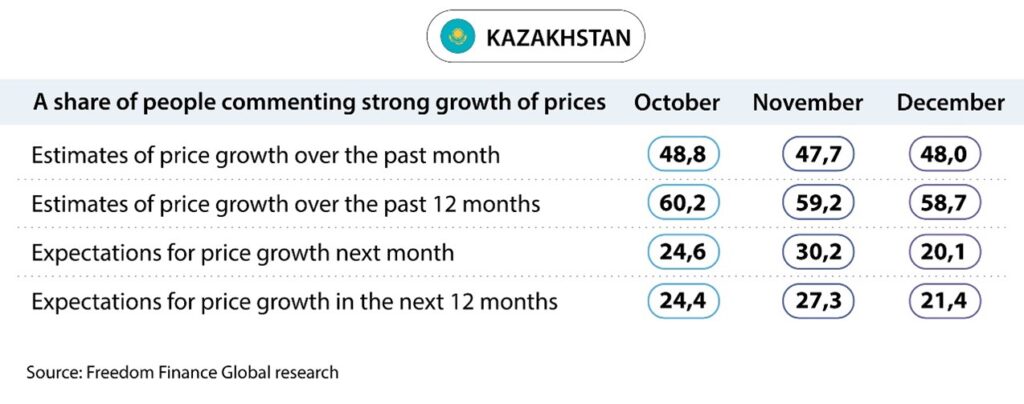
Devaluation expectations fell amid the strengthening of tenge
The devaluation expectations of Kazakhstanis in December decreased markedly and turned out to be the lowest over the past few months. In December, tenge strengthened by 0.8%, and from the beginning of October to the end of the year – by about 5%, which probably led to a decrease in devaluation expectations. 51.8% of Kazakhstanis expect tenge to weaken against the dollar (55.4% in November) in a year, and 30.8% (34.4% in November) – in a month.
The credit confidence index fell by 2.5 points and remains close to the average values of the previous five months. The share of Kazakhstanis who believe that now is a good time to get loans fell from 16.6% to 14.1%. At the same time, the level of deposit trust increased slightly, from 34.1% to 34.4%. This is exactly how many Kazakhstanis approve of bank deposits in the current situation.
The level of calm increased slightly, although many fewer people gave an unambiguously positive answer. 57.9% of Kazakhstanis note that now is a calm time rather than an alarming one (57.3% in November). At the same time, the share of people who gave a clear answer that now is a quiet time fell from 35.8% to 30.9%. Expectations for unemployment growth within one year decreased slightly, from 40.3% to 39.1%. Let us note that concerns about unemployment have reached their lowest level since March. A year ago, the same figure was 39.7%, which indicates the stability of Kazakhstanis’ expectations for unemployment growth.
Uzbekistan
The Uzbek consumer confidence index recovered in December and reached a record value of 135.3 points. The index grew by exactly 3 points, largely due to a sharp increase in optimism in expectations and assessments of changes in personal financial situation. A significant majority of residents believe that their financial situation has improved in 2023, and also expect its further improvement in 2024. The actual assessment of the state of the economy for 2023 has increased slightly.
The personal situation of Uzbek citizens has improved to record values
The subindex of changes in personal financial situation increased to 136.7 points, which is a new record for 6 months of the study. The growth in December was as much as 7 points. This is reflected in an increase in the share of positive responses from 57.3% to 61.6%. By age, young people remain the most positive, 68.1% of young people felt their financial situation had improved in 2023. This is noticeably higher than the November figures of 63.8%. The older generation responded worst of all, with only 51.6% giving a positive answer to the same question. Although compared to November, this share increased slightly by 3.2 percentage points.
Regionally, the Andijan region became the leader, where 71.6% of residents noticed an improvement in their financial situation. Note that this is significantly higher than the November figure of 57.7%. Also, similar progress in December was shown by the Syrdarya region (from 52.8% to 65.6%) and the Kashkadarya region (from 54.5% to 63.8%). The outsiders among the regions were the Republic of Karakalpakstan and Tashkent, where the share of positive responses reached only 53.5% and 53.2%, respectively. However, in the case of Tashkent, we note increase in this indicator by 7 percentage points.
Once again, we note that the cross-section by income level continues to show the expected correlation in all questions regarding consumer confidence, the higher the income, the more positive the answers. Thus, in December, among the richest 79.7% of people noted an improvement in their personal financial situation over the past year, while among the poorest only 34.3% reported this.
The subindex of expectations of changes in personal financial situation also increased significantly: by 7.4 points. 76.3% of Uzbek citizens expect an improvement in their financial situation by the end of 2024. In November there were slightly fewer of them – 71.8%. Among the four age groups, young people under 29 years old performed best again, with as many as 84.7% looking at the future with optimism. The older generation over 60 years old is also mostly optimists, the share of positive answers reaches 68.3%.
Regionally, here too, the Andijan region is the leader with a share of positive responses of 81.1%, although a month ago it reached 75%. It is interesting to note that all regions of Uzbekistan showed improved results. The best progress in December was demonstrated by the Bukhara region, where the share of positive responses increased from 70.2% to 78.1%. The capital continues to be an outsider, where the share of people expecting an improvement in their financial situation is 70.5%. Nevertheless, relative to November, Tashkent showed a significant improvement in this indicator, by 7.4 percentage points.
Slight improvement in economic estimates
The subindex of assessments of changes in the economy over the past 12 months increased from 128.2 to 129.6 points. 55.1% of residents believe that the economy of Uzbekistan will show improvement in 2023. In November this figure was 57.1%, however, then the share of those who gave a clearly positive answer was smaller, 23% versus 29% in December. It is curious that young people remain pessimistic about the economy. 48.6% of young people gave a positive answer, while among the older generation the figure was 61.8%. Regionally, there is no clear leader, but relative to the rest, the Navoi region, the Bukhara region, the Jizzakh region and the Andijan region can be distinguished, where the share of positive answers is in the range of 58–63%, with different proportions of clearly positive answers. On the other hand, there is a clear outsider among the regions, Tashkent with a result of 43.3%.
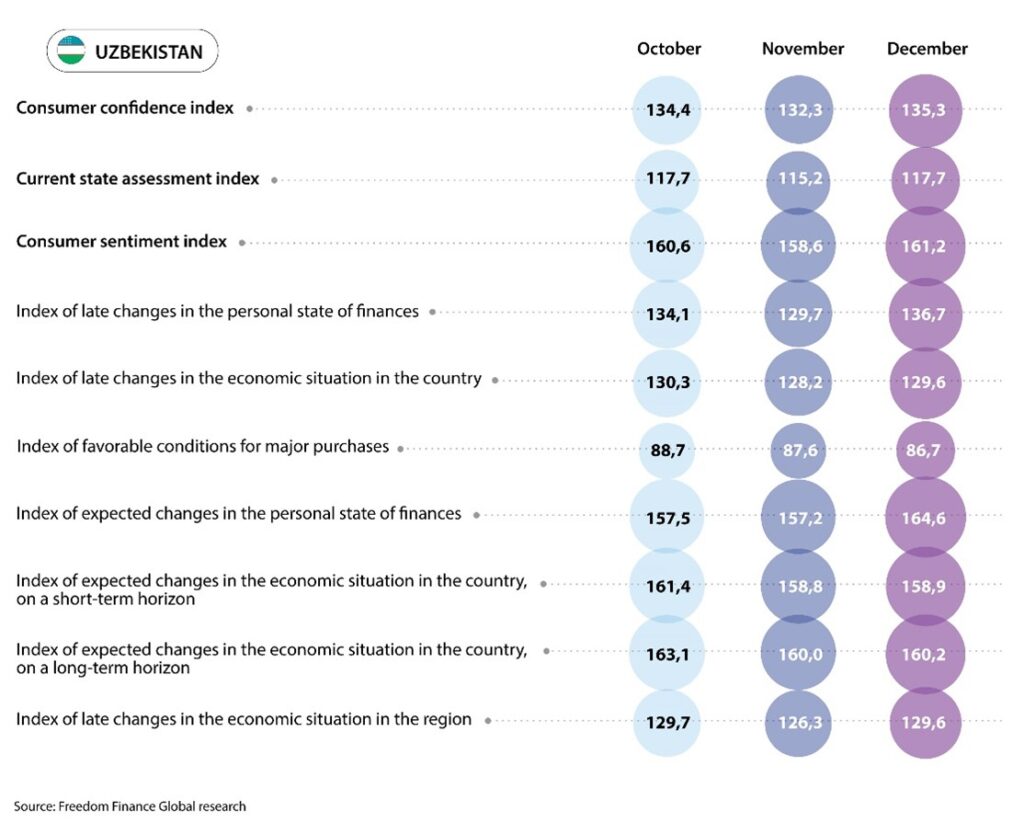
Inflation expectations have fallen sharply
Uzbekistan’s inflation estimates in December essentially remained at the same level. The share of respondents who felt a very strong increase in prices over the past month increased slightly, from 29% to 29.3%. Regarding the one-year horizon, inflation estimates also increased slightly. 47.2% of residents noticed faster growth over the past year, slightly higher than the November figure of 47%. Officially, monthly inflation accelerated from 1.13% in November to 1.24% in December, well in line with the 2021-2022 average. As a result, annual inflation also remained at the same level, as did residents’ estimates, increasing from 8.76% to 8.77%. However, this is the lowest value in more than 7 years.
Among individual food products, for the fourth month in a row, the leaders were «meat, poultry» and «flour». Nevertheless, for flour, the percentage of people who noticed a strong rise in prices continues to decline, from 37.6% to 32.8%. You can also see a slight decrease in the same indicator for meat and poultry – from 53.2% to 47%. It is interesting to note that the top 3 in this category included gasoline, a strong increase in prices of which was noticed by 31.9% of residents of Uzbekistan. The media note that prices for AI-80 gasoline at all types of gas stations have increased by about 10–12%. This was due to the end of the zero excise tax rate. In addition, according to official statistics, gasoline prices in December rose on average by 3.3% mom, and propane prices by 5.1%. On the other hand, officially prices for flour and meat in general decreased by 0.1-0.3% m/m in December.
We record a significant decline in inflation expectations. Only 14.9% of Uzbek citizens expect a strong rise in prices during the month, which is a new record for 6 months of the study. Inflation expectations over the one-year horizon also dropped to record low levels. The share expecting faster growth during 2024 fell from 26.8% to 24.2%. In general, we can cautiously conclude that this is a consequence of the general fall in inflation in 2023 to multi-year lows.
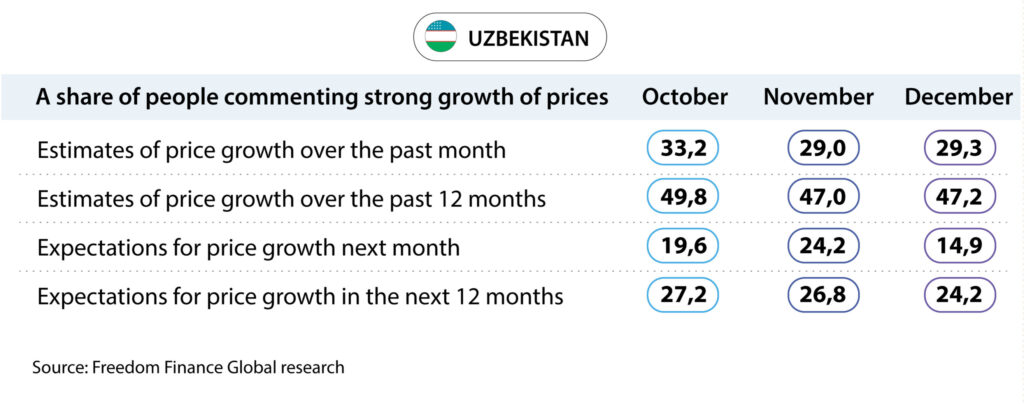
Devaluation expectations in Uzbekistan remain at high levels
In December 2023, devaluation expectations of residents of Uzbekistan remained at approximately the same levels. The share of those who expect the som to weaken against the dollar over the next 12 months increased slightly, from 65.8% in November to 66.5% in December. But over a one-month horizon, the share of pessimists decreased insignificantly from 48.9% to 47.4%. Although in December we saw new highs for the dollar against the som, in the end the rate increased only by 0.06%. However, in the first 12 days of 2024, the dollar went even higher and is growing by 0.8% to the som, which to some extent indicates the realization of the devaluation expectations of the population. Let us recall that these expectations in Uzbekistan remain the highest in Central Asia.
Credit confidence fell for the second month in a row in December. The number of those who say now is a good time to take out loans fell from 31.6% in November to 29% in December, a new low in the six months of our survey. The changes in the deposit index are insignificant: the index fell from 57.7 to 57.6 points. 39.8% of Uzbek citizens (39.5% in November) believe that now is a good time for deposits. The calm index fell for the second month in a row. If in November 78.2% of residents said that now is a quiet time in one way or another, then in December the share of such answers fell to 77.1%. But at the same time, the share of those waiting for unemployment to rise during the year decreased from 41.1% in November to 38.3% in December, which is a new minimum in our study.
Kyrgyzstan
In Kyrgyzstan, the consumer confidence index in December decreased by 1.6 points and reached 130.2 points. The index fell for the first time since August, but the overall result still shows that positive responses significantly outweigh negative ones. Four of the five sub-indices showed declines other than expectations for the economy over the next 12 months. The subindex of favorable conditions for large purchases fell the most, by 4.4 points. Assessments for both the economy and personal financial situation for the past 2023 have also dropped noticeably.
Conditions for large purchases have become slightly worse
Regarding the favorableness of current conditions for large purchases and expenses, 36.8% of Kyrgyzstanis gave a positive answer, although a month ago there were slightly more such figures: 39.1%. In terms of age, the decline can be seen in all categories. The peculiarity in this country, which is expressed in the prevalence of negative responses in the age group of 30–44 years, continues to persist. 35% of people of this age gave a positive answer, among the oldest generation this figure was 38%. In the regional plan, in December a decrease in the share of positive answers is recorded in all regions except the Issyk-Kul region. The share of such people did not change and remained at 37%. The leader was the Jalal-Abad region with a result of 41.8%, which is higher than the share of negative responses by only 0.8 percentage points. The outsider among the regions is the Chui region with a share of positive responses of 30.5%, which is noticeably lower than the November value of 35.1%.
Actual assessments of the economy and financial situation have worsened
Kyrgyzstanis’ assessments of changes in the economy and personal financial situation have dropped noticeably, although the positive continues to prevail over the negative. 57.4% of residents believe that the economy has shown improvement over the past 12 months. In November, such respondents were 60.4%. Once again, the 30-44 age group performs the worst, with 54% of people in this age group being optimistic. Among the oldest generation, the share of such people reached 63%. In general, the overall decline in positivity was largely due to young people under 44 years of age. Among the regions, the Batken region went against the downward trend, where the share of those assessing positive changes in the economy increased from 71% to 77%, which was the best result in December. The Chui region and Osh performed the worst, where this figure was 44% and 45%, respectively. At the same time, in Osh the decrease turned out to be much more noticeable, from 60% to 45%.
In the question of assessments of changes in personal financial situation, one can also see decrease in the share of positive answers from 48.8% to 46.8%. The decrease, oddly enough, occurred in all age groups except 30–44 years old, in which the share of positive responses fell from 46.1% to 44.8%, but at the same time the share of negative responses also decreased from 15.2% to 12 ,1%. However, 44.8% is still the lowest result among all categories. However, if we also take into account negative answers, then the worst becomes the group of 45–59 years old, in which the share of negative answers reaches 17.2%. Young people performed best, among whom slightly more than half believe that their financial situation has improved in 2023. In regional terms, improved results can be seen in the Naryn region (+9 p.p.), the Batken region (+8 p.p.) and the Jalal-Abad region (+1 p.p.). The Osh region became the best, where the share of positive responses is 54%. The Chui region again performs worst of all with a result of 34%. Let us note a sharp drop in the indicators of the Talas region: from 48% of positive responses in November to 36% in December.
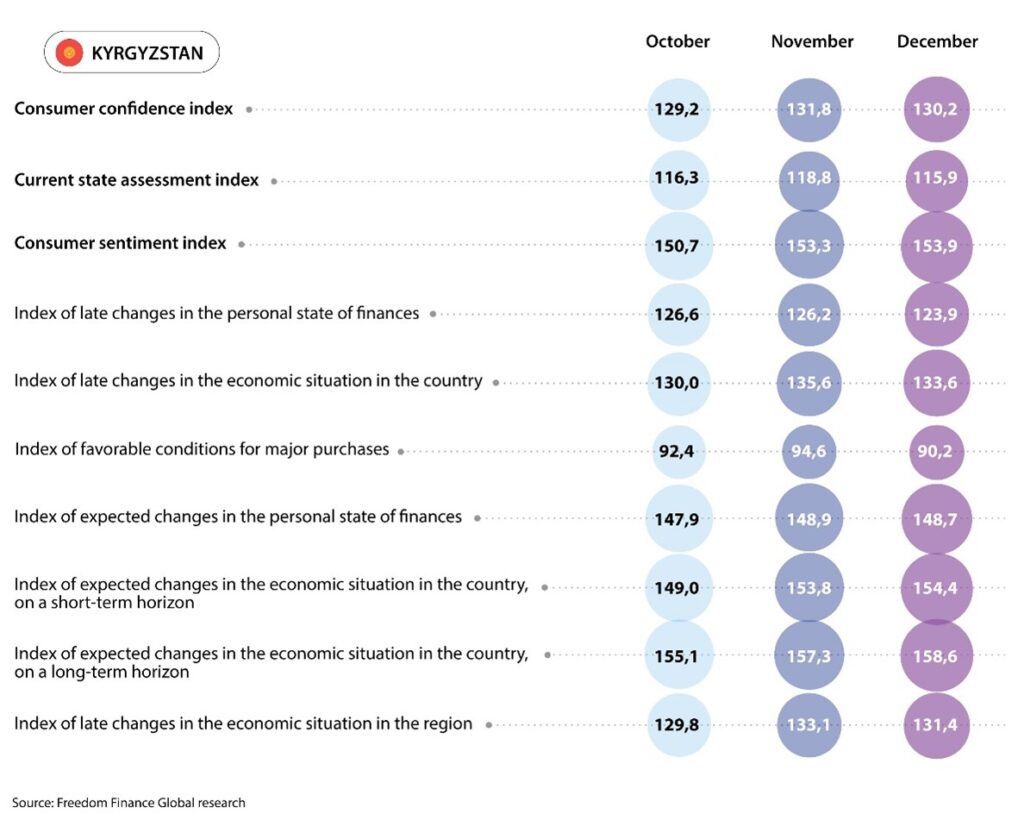
Inflation expectations remain low, and inflation is slowing significantly
Inflation estimates and expectations of Kyrgyzstanis showed multidirectional movement. However, inflation expectations are again the lowest in the region. The share of those who expect a very strong rise in prices within a month decreased from 9.2% to 8.2%, and in the one-year horizon the share of pessimists increased slightly, from 11.8% to 12.6%.
Estimates of price growth over the past month have increased slightly, although they remain below the July-October levels. In December, the share of those who noticed a very strong increase in prices increased from 31.8% to 33.4%. However, the share of those who believe that prices have not changed reached a new record during the six months of the study – 7.6%. Regarding the rise in prices over the past year, a reverse decrease in the number of people experiencing a stronger rise in prices than before has been recorded. The share of such respondents decreased from 61.6% to 58.9%, which is a repetition of the October value, as well as the lowest figure in 6 months.
Official inflation in the country continued to decline for the third month in a row in December. At the same time, the slowdown again turned out to be quite sharp, from 8.1% to 6.9% in annual terms. The last time such a low inflation rate was recorded was in September 2020.
In Kyrgyzstan, residents are still very concerned about the prices of flour, which continues to rank first among goods and services for which the largest price increases are noticeable. 62.2% of respondents indicate flour, although in November there were slightly fewer of them – 61.7%. Kyrgyzstan is the only country in the Central Asian region where flour concerns persisted in December. Also, among the leaders continue to be vegetable oil (50.6%), sugar and salt (36.9%), meat, poultry (36.9%), vegetables and fruits (36.2%). The list of top-5 food products for which the most people noticed an increase in price remains unchanged for the fourth month in a row. In addition, for all of them, more people noticed a strong increase in prices relative to November.

Slight increase in devaluation expectations in Kyrgyzstan
The Kyrgyz som strengthened slightly in December for the second month in a row, by 0.1%. However, residents’ devaluation expectations increased slightly. If in November 30.3% of residents expected the som to weaken in a year, then in December this figure was already 31.7%. On the issue of dollar growth over a one-month horizon, the share of pessimists did not increase so significantly, from 18.2% to 18.4%.
The population’s credit confidence remains stable. Over the month, the share of those who believe that the current situation is favorable for obtaining loans has not changed and is 22%, with an average value for the six months of the study being 22.5%. Deposit confidence of Kyrgyzstanis decreased slightly, the share of positive responses fell from 32.8% in November to 31.3% in December. The calmness index continues to grow for the fifth month in a row, 64.3% of residents believe that now is a calm time, while the share of those who are worried was only 25.2%. Last month these figures were 63.8% and 26.9%, respectively. Residents’ expectations for an increase in unemployment fell for the third month in a row and reached a new record, only 29.8% of residents expect unemployment to increase, although in November this was 31.3%, and in September – 36.1%.
Tajikistan
The consumer confidence index in Tajikistan fell from 151.1 to 148.6 points in December, which happened for the first time in six months of this study. Yet consumer confidence in Tajikistan remains the highest among the four Central Asian countries under consideration. The main decrease occurred in the subindex of favorable conditions for large purchases. Expectations for changes in personal financial situation have also noticeably decreased; this is happening for the second month in a row.
Conditions for large purchases returned to negative zone
The subindex of favorable conditions for large purchases in December sharply decreased by 8.1 points and returned back to the negative zone. That is, the share of negative answers to this question exceeds the share of positive answers. The subindex indicator itself reached 93.2 points, which is slightly lower than in October and November, but significantly higher than the indicators in July-September. 45.6% of residents of Tajikistan note that now is one way or another a favorable time for large purchases and expenses, although last month there were 49.7%. The share of negative responses increased from 45.9% to 50.4%.
Age differences continue to preserve traditions. Thus, the category of people 45–59 years old again shows the worst results. Only 39.7% of people in this age category gave a positive answer. Among the younger generation from 18 to 29 years old, positivity continues to prevail, 52.3% said conditions were favorable for large purchases, compared to 51.2% in November. In regional terms, in December the Sughd region took the lead with a share of positive responses of 47.6%. The worst response was in areas of republican subordination, but the lag in this region is not that great, 41.7% of positive responses.
Expectations regarding personal financial situation have worsened again
Among the negative trends, we can note the worsening of expectations for changes in personal financial situation for the second month in a row. The subindex on this issue fell 4.9 points, after a slight decline of 0.9 points in November. The share of positive responses decreased from 74.2% to 68.2%. In terms of age, one can again see the leadership of the younger generation, 76.8% expect an improvement in their financial situation within a year. Although a month ago there were 82% of them in this category. People over 60 years of age responded worst to this question, 58.7% of whom chose positive answers. Note that in November this figure was 70%, which suggests that this age group was the main driver of the decline.
Among the regions, the Sughd region again stands out, where 59% expect a significant improvement in their financial situation. On the other hand, the Gorno-Badakhshan Autonomous Region showed a positive response rate of 87%. However, only 35.7% of people expect significant improvement there. Dushanbe was an outsider this time, where only a little more than half of the people gave positive answers to this question.
The remaining subindices did not show significant changes in December.
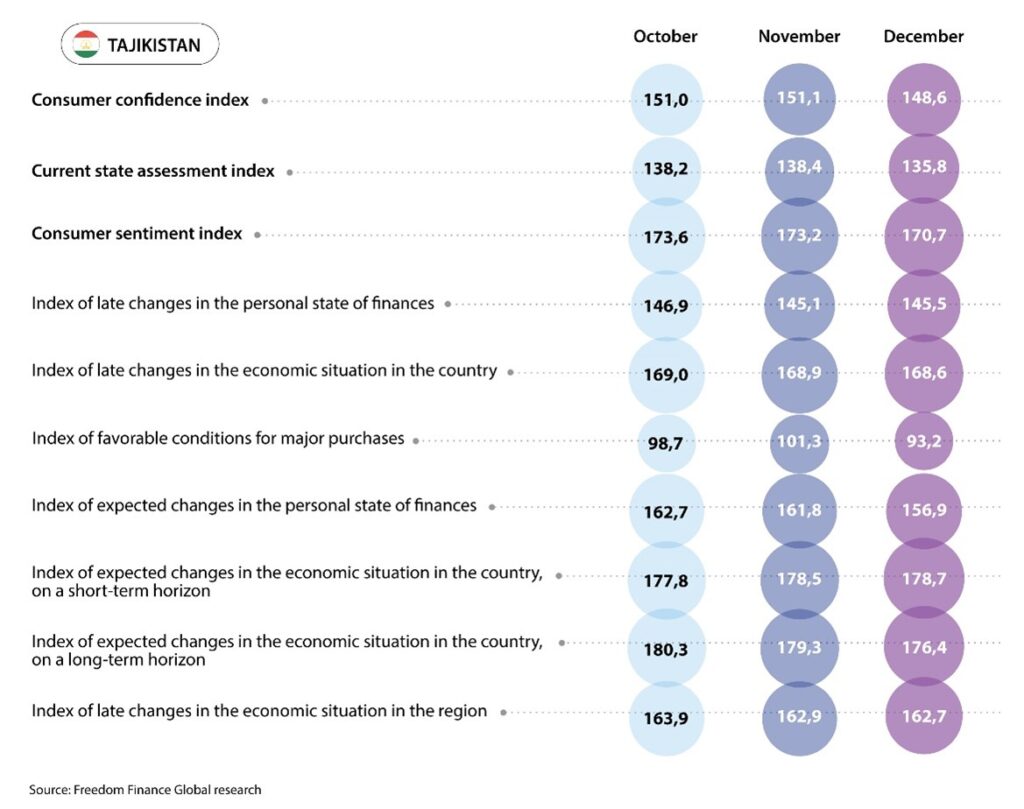
Rising prices are becoming less and less of a concern
Inflation estimates and expectations of Tajiks in general decreased slightly in December. Moreover, the decline occurs for the third month in a row. Residents’ feelings of inflation fell the most. 25.1% noted a strong increase in prices over the past month, while in November there were 27.1%. The share of those who experienced a faster rise in prices over the past 12 months also decreased, from 36.9% to 34.5%.
Changes in inflation expectations turned out to be small. But this is quite natural, given the initially low expectations. Only 12% of residents expect a very strong rise in prices in the next month. In November there were slightly fewer such people, 11.3%. In general, the share of those waiting for at least some price increase decreased: from 46.2% to 41.2%. As for expectations over the next 12 months, the decline continues. In December, those expecting an acceleration in price growth in the year-end decreased from 13.6% to 12.1%, which is the lowest value over the six months of the study.
Inflation data for December has not yet been published, but we are aware that annual inflation slowed from 4.4% in October to 3.7% in November. Let us recall that in August and September inflation rose sharply to 4.2 and 5.1%, respectively. These months marked the growth and peak of inflationary feelings and expectations, according to our survey, which indicates a noticeable correlation of responses with official statistics.
Among individual goods, residents of Tajikistan continue to be most concerned about the prices of flour. 49.4% of residents noticed a strong increase in flour prices, although this share continues to decline. In September there were 73% of such residents. Vegetable oil, vegetables and fruits also hold the lead. If for vegetable oil the share of those who note a strong increase in prices fell from 37% to 31.6%, then for vegetables and fruits, on the contrary, one can see an increase from 20.7% to 24.7%, which is probably a consequence of the seasonal factor. The decline in these indicators again correlates well with official statistics. In November, prices for flour fell by 0.5% MoM, for vegetable oil – by 4% MoM, and for fruits – by 2.8% MoM.

Slight decrease in expectations for weakening of somoni
Devaluation expectations in Tajikistan continued to decline in December and turned out to be the lowest over the entire six months of the study. In December, the dollar to somoni exchange rate remained virtually unchanged and remained stable for the tenth month in a row. The share of those who expect the national currency to weaken within a month increased slightly – from 16.9% to 17.2%. Within one year, 22.7% of the country’s population expects weakening (25.3% in November).
Credit and deposit confidence indices fell in December. 24.6% of the country’s residents believe that now is a good time to get loans, although in November this figure was 27.6%. Regarding deposits, a similar question caused a little more optimism. But the share of positive responses fell from 53.7% to 52%. The calmness index has increased: 87% of residents say that now is a calm time, while in November this was 84%. Unemployment expectations fell for the third month in a row. 28% of respondents expect an increase in unemployment compared to 30.9% in November.
Conclusions
In December, we note general decline in consumer confidence in all Central Asian countries under consideration, except for Uzbekistan. Nevertheless, 2023 ended on a positive note, since in all countries consumer confidence was above the neutral limit of 100 points. One, here again Kazakhstan stands out, where the result barely crossed this border. But still, relative to December 2022 or July 2023, the result turned out to be more confident. In addition, if we compare the indicators with the first month of the study of the entire region (July), we note a noticeable increase in consumer confidence in all countries. Tajikistan continues to remain the leader, despite the decline and noticeable reduction in the backlog by Uzbekistan. In Kyrgyzstan, the drop in consumer confidence turned out to be insignificant.
In Uzbekistan, which became the only country where consumer confidence increased, residents’ assessments of changes in the economy and personal financial situation improved significantly and to record levels. Moreover, almost all regions showed growth for the most part, which, for example, did not happen in Kazakhstan. There, the November leaders represented by the Kyzylorda region and the Zhetysu region showed weak results in December. This probably suggests that in November it was in these regions that we saw a one-time surge in results within the statistical error. In Kazakhstan, assessments of favorableness of current conditions for large purchases and expenses fell the most. Note that this parameter decreased in December throughout the region and is the only one that is in the negative zone below 100 points in all four countries. That is, the proportion of negative responses prevails over positive ones. In Kyrgyzstan, this subindex showed the largest decline, as well as in Tajikistan. Moreover, in these two countries, assessments of changes in personal financial situation also fell.
Inflation expectations have largely fallen in Central Asia. Thus, the strongest decline can be seen in Kazakhstan and Uzbekistan, where they were the largest in the region. The low expectations that developed in Tajikistan and Kyrgyzstan remained at approximately the same level. It is interesting to note that the peak of inflation expectations in these countries occurred in September, when annual inflation in Kyrgyzstan practically did not fall, and in Tajikistan, on the contrary, it grew. In addition, then the prices for flour increased greatly, which greatly worried the residents. However, concerns about flour continue to decline in all countries except Kyrgyzstan, where the majority of residents mention flour in surveys. On the other hand, in some countries in December one could see a sharp increase in concerns regarding certain products. Thus, in Kazakhstan, more residents noticed a strong increase in prices for eggs, and in Uzbekistan – for gasoline and fuels and lubricants. At the same time, official statistics also recognize the increase in prices for these goods in December. Actual inflation fell in Kazakhstan and Kyrgyzstan to multi-month lows, while in Uzbekistan it still remained at the November level.
Devaluation expectations in the region as a whole remained at approximately the same level. However, Kazakhstan stands out on a positive note, where expectations for a weakening tenge fell to multi-month lows in December amid a strengthening of the tenge throughout the last quarter. In Kyrgyzstan and Tajikistan, devaluation expectations continue to be at low levels, due to exchange rate stability. In Uzbekistan, where expectations for a weakening national currency are the highest in the region, most residents remain concerned about the dollar’s rise amid new record exchange rates.
The sixth wave of research into consumer confidence of residents of four Central Asian countries showed that the population of the region as a whole looks positively at the results of 2023 and the coming 2024. However, consumer confidence fell in three countries, in December. Whether this is the start of a new downward trend will be known in the coming months. We also note the general decline in inflation expectations, which was a positive response to the conclusions and questions raised in the previous material based on the study. The increase in expectations in November, apparently, turned out to be one-time. Moreover, population estimates of inflation and official inflation in the region continue to fall. Certain commodities, as the study shows, can cause inflationary feelings and expectations to rise, so regulators need to closely monitor critical commodities and their supply on the market.






